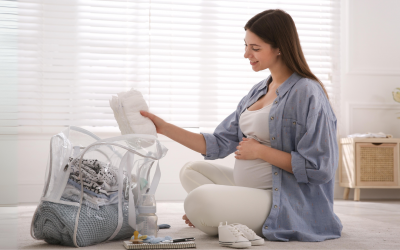Are you an expecting or new mom feeling overwhelmed and confused by the term diastasis recti? You’re not alone! This “mysterious word” is a major concern, with searches like “what is diastasis recti?,” “how to fix diastasis recti?,” “how to fix diastasis recti years later?,” and “what does diastasis recti look like?” happening hundreds of thousands of times daily. When I was pregnant, I experienced the same uncertainty. Everyone talked about this post-pregnancy condition, the need to “fix it,” but clear guidance was scarce.
Searching online for answers can often lead to even more confusion, with seemingly contradictory advice. Some experts advise against exercises like crunches and planks with diastasis recti, while others suggest they are perfectly acceptable. This was my experience even in a country with excellent healthcare and postpartum support. Imagine the frustration for countless other pregnant and postpartum women seeking clarity! This confusion can lead to simply trying things without a plan or, worse, being paralyzed by the fear of doing something wrong.
Before we address the common myth about doing crunches with diastasis recti and guide you on how to ensure your healing exercises are effective, let’s clearly understand what diastasis recti actually is.
What Is Diastasis Recti (DR) or Abdominal Separation?
Diastasis recti, also known as diastasis rectus abdominis (DRA) or simply abdominal separation, is a very common and natural occurrence during pregnancy. It happens when your rectus abdominis muscles, often referred to as your “six-pack abs,” separate to accommodate your growing baby. It’s important to understand that this separation doesn’t create a hole. Instead, the linea alba, the connective tissue between the left and right sides of your rectus abdominis, stretches and thins.
As a result of this stretching, your belly may protrude because your abdominal muscles lack the strength to effectively support your internal organs and maintain core tension, especially during exercise.
While there are different types of diastasis recti, we will focus on the general understanding and management in this article.
Do you have diastasis recti? Here is a video where I show you how you can check it yourself:
The Misconception About the “Gap” in Diastasis Recti:
When it comes to doing exercises like crunches with diastasis recti, the biggest misconception is focusing solely on the width of the separation or “gap.” While the gap is a factor, it’s not the only, or even the most crucial, aspect. You can have a noticeable gap but still possess a strong and functional core. Conversely, you might have minimal or no gap (officially not meeting the diagnostic criteria for diastasis recti) but still have poor core strength and coordination.
The Real Issue: Intra-Abdominal Pressure and Core Coordination:
Poor core coordination can lead to excessive intra-abdominal pressure, which can manifest as a visible bulging or “coning” or “doming” of your belly during movement. This improper pressure management is a significant contributor to the development and persistence of diastasis recti. This is why diastasis recti isn’t exclusive to pregnant or postpartum women; it can affect anyone, including men and children.
So, How To Do Crunches (and Other Exercises) Safely With Diastasis Recti?
The foundation of successful diastasis recti recovery and safe exercise lies in learning proper core coordination. For new mothers, this typically begins with a guided postpartum recovery program led by a qualified professional specializing in this area.
The Importance of the Reconnection Breath:
A crucial first step is often the reconnection breath. This specific breathing technique helps you correctly engage your deep core muscles, including all the abdominal muscles, the diaphragm, and the pelvic floor. This foundational engagement alone can significantly contribute to healing your diastasis recti.
Progressive Overload and Core Exercise Intensity:
Once you’ve mastered the reconnection breath and basic core engagement, you can gradually increase the intensity of your core exercises. Remember, absolutely every movement can be a core exercise when performed with proper core engagement and breathing. Just like you learn to breathe effectively during labor, learning to breathe correctly during exercise is key to managing intra-abdominal pressure and strengthening weakened abdominal muscles.
Think of it as progressive overload, the same principle you would apply when strengthening any other muscle group. You wouldn’t start weightlifting with the heaviest weights. Instead, you’d begin with bodyweight exercises or lighter loads and gradually increase the challenge as you get stronger. You wouldn’t achieve strong glutes by only doing bodyweight glute bridges indefinitely.
Crunch or Not to Crunch? The Answer:
So, to directly answer the popular question: Yes, you can do crunches and planks even with diastasis recti, provided you can effectively manage your intra-abdominal pressure and avoid any coning or doming of your belly.
You might start with mini-crunches with a very small range of motion, consciously pushing the sides of your rectus abdominis muscles towards each other as you lift slightly. As your core strength improves, you can gradually increase the range of motion or even add short holds at the top. The ultimate goal is to be able to perform a full-range crunch with a completely flat belly throughout the movement. This is achievable even if a small gap persists!
The Holistic Approach to Fixing Diastasis Recti:
There is no single “magic bullet” exercise to fix diastasis recti. Instead, successful healing comes from a well-rounded training program that incorporates a variety of exercises designed to improve core strength, coordination, and manage intra-abdominal pressure. A well-designed prenatal exercise program can even help minimize the severity of diastasis recti development during pregnancy. Similarly, a comprehensive postpartum recovery program will equip you with the necessary tools to heal your entire core and address your diastasis recti.
Book your free consultation here:
If you’re navigating the challenges of diastasis recti and need personalized guidance on your prenatal or postpartum recovery journey, please feel free to connect with me. I’m here to help!



